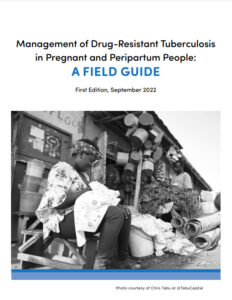
SUMMARY AND KEY POINTS
Pregnant people are an under-served and complex population when it comes to drugresistant tuberculosis (DR-TB). The complexity of pregnancy and DR-TB extends far beyond their physical susceptibility to DR-TB and includes risks for: receiving sub-standard care; experiencing stigma and discrimination; being separated from their children; and facing tremendous suffering due to a lack of compassionate counseling. The goal of this field handbook is to develop communities of service and promote best practices in the care of pregnant people with DR-TB throughout all phases of their pregnancies and in the peripartum period. Although there are limited data on the care of such individuals, those that do exist show that most pregnant people with DR-TB and their infants can be safely treated and go on to lead healthy, productive and normal lives. These data are supplemented by the experiences of the providers who have come together to develop this guide and to cultivate a series of best practices. This field guide provides more detailed information that can be followed not only for the care of pregnant people with DR-TB but which can be adapted to improve services for people with all forms of TB who are pregnant.
The most important practices for care in these individuals include access to:
• Free family planning services at all stages of DR-TB diagnosis and treatment so that people can be in control of their reproductive lives while working to regain their health from their DR-TB;
• WHO recommended diagnostic tests, including rapid molecular tests and chest radiography as well as to routine screening for DR-TB given the heightened risk of developing TB during pregnancy;
• Compassionate counseling and support for either continuing or terminating a pregnancy when the person is also living with DR-TB, depending on the preferences and needs of the pregnant person;
• Effective treatment (including with newer drugs such as bedaquiline, delamanid, linezolid and the third-generation fluoroquinolines), even if specific data on pregnant people are lacking due to their limited inclusion in studies (although drugs that are known to cause reproductive toxicity such as pretomanid or clear damage to the developing fetus such as the injectables should be avoided if possible);
• Routine monitoring to ensure treatment is progressing well and that side effects are being assessed, managed, and minimized;
• Skilled medical care and support during all phases of pregnancy—including delivery— without unnecessary and discriminatory infection control practices being enforced beyond what is provided to other pregnant people (with some rare exceptions for people who are only recently started on DR-TB treatment);
• Their newborn child and the right to feed that child in a way that promotes the health of the newborn and the postpartum parent and aligns with the parent’s values, preferences and needs around feeding;
• Support to remain on therapy for DR-TB with practical information about the risks and benefits of all aspects of treatment provided by informed and compassionate staff.